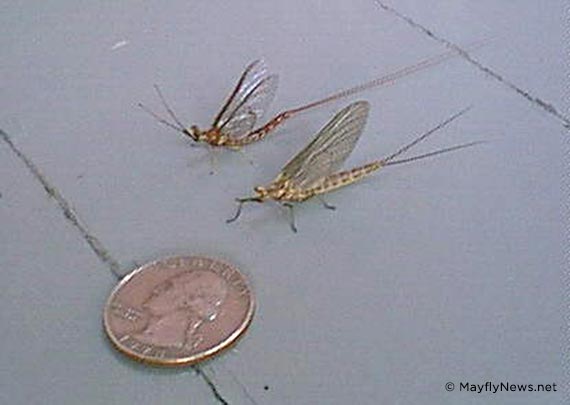
Mayfly Facts / FAQ
Amaze your friends with knowledge!
They are known by several names - Junebug, Mayfly, Canadian Soldier, Fishfly... and a few others that I will not print here due to... well... this is a family show, folks. Their official scientific name is 'Hexagenia'.
Mayfly bodies measure about one inch long and tails range from 1/2 to 3 inches in length. Color and size vary, but there appears to this reporter to be two main types, or species, of mayflies in this area of Pt. Clinton, Ohio. The larger variety have thicker bodies with a yellowish golden color. They normally have shorter tails (sometimes forked in a V shape) but the tail may be longer after they shed. The other variety have smaller, very dark, bodies and longer tails.
This photo shows a side by side comparison of a golden variety (foreground) and the smaller longtail. Mayflies are always more than happy to pose for photos.
Mayfly Video
Cleveland's own Fox photojournalist Ali Ghanbari offered to let me link to this video segment he shot on the mayflies. If you've never seen the mayfly invasion in person, this give you a very good idea of what it looks like.
This video was shot on Kelly's Island, a beautiful island north of Sandusky, Ohio and just east of South Bass Island (Put-in-Bay). Kelley's Island offers some of Lake Erie's finest natural highlights. In addition to the Indian Rock and the butterfly house, the Glacial Grooves are worth the trip, alone.
But Kelley's is also host to mayflies and as Ali Ghanbari finds out, not all the residents welcome our wonderful little guests!
Mayfly Q & A
NO, they can't bite because they don't have a mouth. They also don't have a stinger. They are totally harmless so relax and enjoy them. Set one on your shoulder. They love to hang out with people!
The return of the friendly mayfly is attributed to Lake Erie being its cleanest in years. Part of this may very well be due to the arrival of the Zebra Mussels from Europe. The zebra mussel was brought to Lake Erie in ballast water dumped from ocean freighters. These minature clam looking things have raised havok in every possible way on anything related to the lake. The one positive thing they have done is clean up the water. Remember when the river in Cleveland caught fire because it was so polluted? Yea, that kind of pollution is bad for mayflies - and none too good for anything else, either.
DO NOT USE THE HOSE TO WASH THEM OFF THE SIDE OF YOUR HOUSE!! Did I say that loud enough? You will end up with the stinkiest fish smelling mess you can imagine. The best way to blow them out of your way is to use a broom or leaf blower.
Nope. Citronella will not work... or bug sprays. If there was something that kept them away, I'm sure the local businesses around Lake Erie would be using it. Keeping lights off at night is the only way we know to decrease the onslaught of mayflies. Notice I said 'decrease.'
From their Mommies (I couldn't resist). Mayflies usually live for 24-72 hours. Don't forget that they've already spent 1-2 years on the bottom of the lake as a nymph living burrowed in the mud. Within that three days, though, they manage to get into about everything you can imagine. You will find dead mayflies lying around on the sidewalks, in spider webs, on window ledges, etc. They'll go anywhere where there's light at night. Wear a white shirt outside at night and you'll see what I mean.
Plan your vacation in early May or after mid-September. That's about the only way you'll avoid them. Since they're totally harmless, don't worry about them and have a good time. Just remember that mayflies are a sign of a healthy ecosystem - a healthy Lake Erie.
Wind direction and weather conditions has a lot to do with how many mayflies you'll see on any given night.
Mayfly Shedding Its Skin
These remarkable pics were taken in Port Clinton, Ohio. They show the shedding, or molting, process that many mayflies undergo. After I remembered what the bugs do just before shedding, it was easier to find one. What is that, you ask? Normally mayflies keep their wings up and together and their bodies arched proudly back with their two front legs up and together. When they are ready to shed, they get a firm grip with all six legs (they also do that in windy conditions - like on your car windshield at 40 mph) and spread their wings out flat against whatever they happen to be hanging on to. You can literally watch them crawl out of their skin. The process usually takes about 5 minutes. After they molt, I see no visible difference. They look exactly the same as before.
Sometimes, if their grip wasn't good enough, their feet will let go and they will be caught half in and half out with no way to pull themselves out of the skin. They usually get out, though and what is left is a white shell that weighs almost nothing and come floating down like snowflakes when the wind blows them off whatever they're attached to. You can find thousands of skins in the grass or on the edge of sidewalks where the wind blows them into piles.
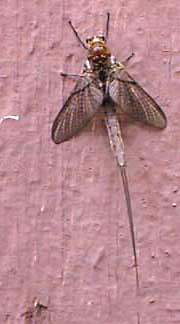
Just getting started
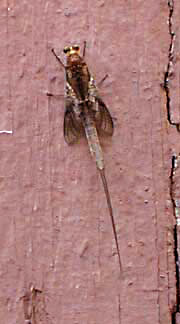
PULL !!
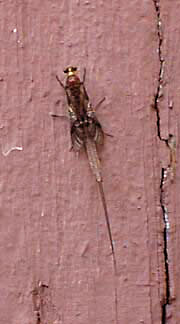
PULL !!
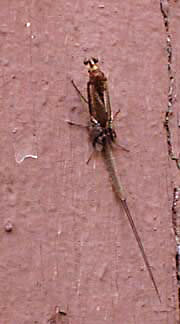
Almost there!
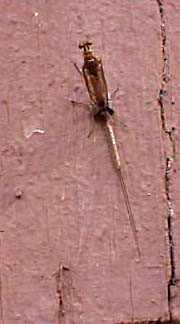
A little more
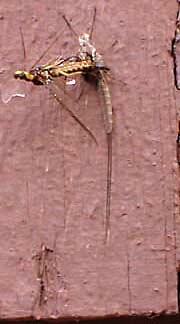
Ahhhhh !!
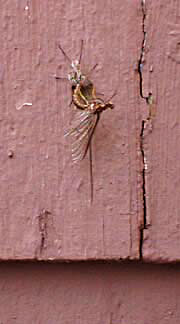
Whoa... better get a grip
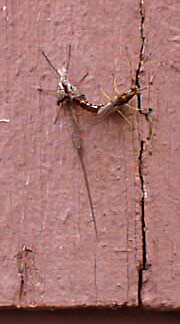
Hangin' on
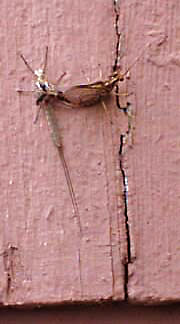
Pull the rear out
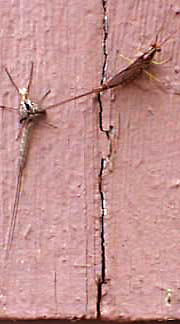
Finally the tail
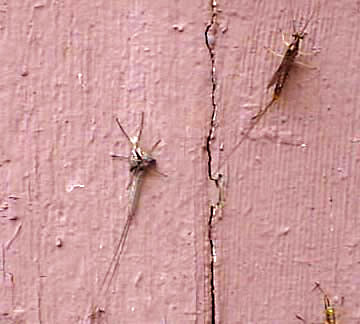
Free at last !!
Want More Mayfly Info?
Mayflies & Muffleheads
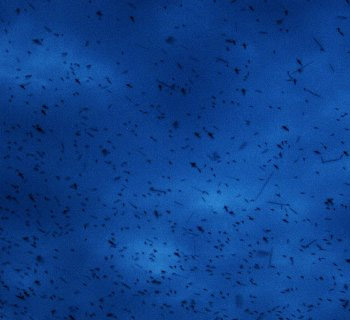
As many pictures as I have of mayflies on this site, there still seems to be some confusion between mayflies and muffleheads. I don't quite understand how, but hey, not everyone's into bugs. I will try to clear that up right now so watch and listen up, folks!
Muffleheads usually show up one to two weeks before the mayflies and are alot smaller than mayflies. They are slightly larger than mosquitos but will not bite you. They also have fuzzy little antennae.
These great photos were submitted by Gwen DeBoard of Columbus, Ohio. The first one is a closeup shot of muffleheads. She took them in Geneva, Ohio at the Geneva State Park Beach by the restroom walkway on June 6th, 2009.
Muffleheads Swarming
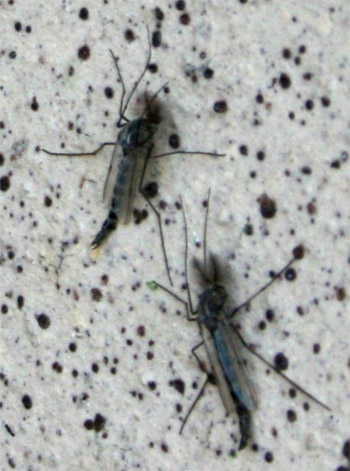
"I was on that Beach until the sun went down, I didn't see one Mayfly, but we did see thousands of muffleheads..... I looked up in the sky and saw & heard swarms. It was amazing! And the sound was incredible! Loud humming like bees. It's hard to believe because they're so small, but I supposed if you get that many mufflehead all flying at once, they're bound to make some kind of noise."
Now, if you'll notice, folks, there's no wings sticking up and no long tail. Yes, they can swarm like mayflies but you won't have them hanging around smelling like dead fish all over the place. They are a lot less of a nusiance than the mayflies.
That is about it. Do we know the difference now? Good... class dismissed!! And thanks for your help, Gwen!


